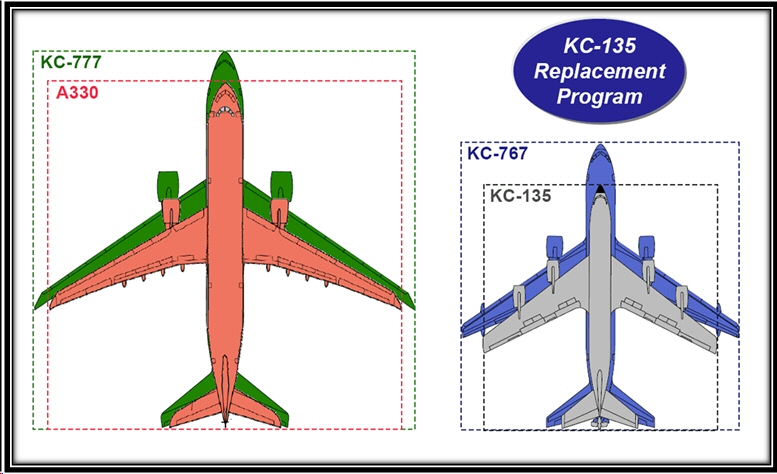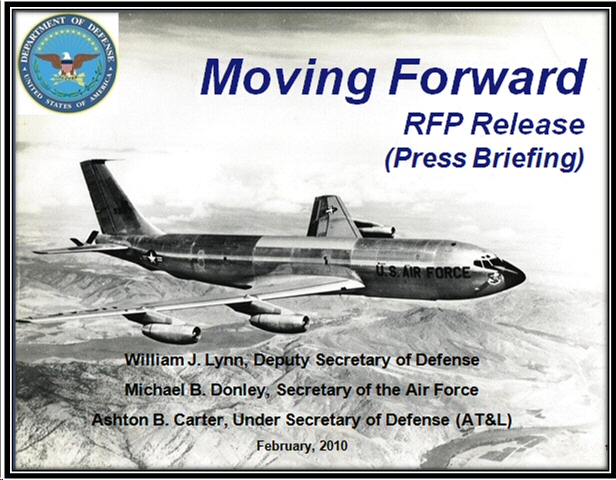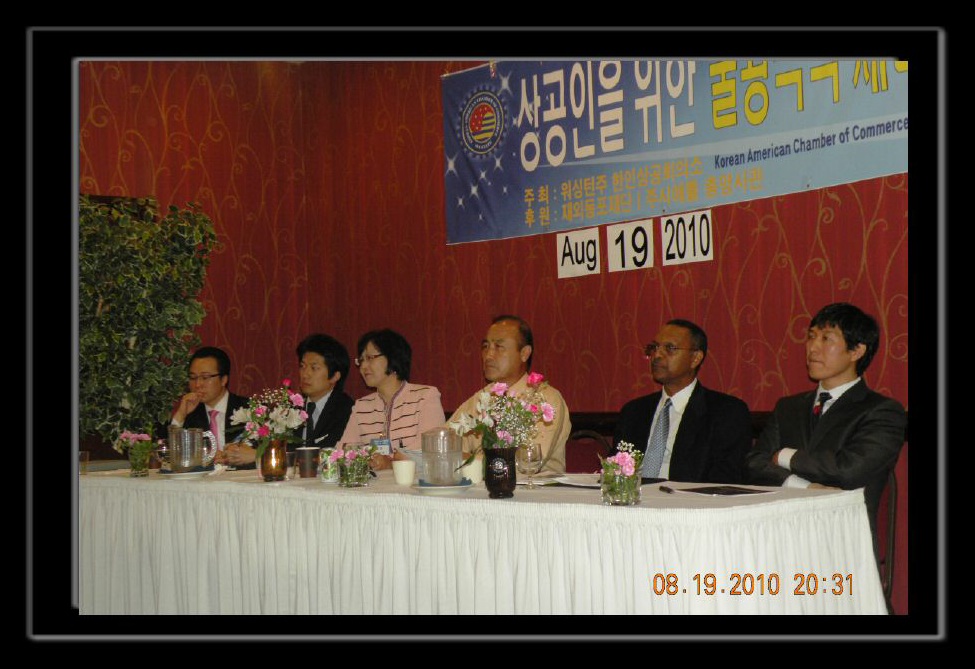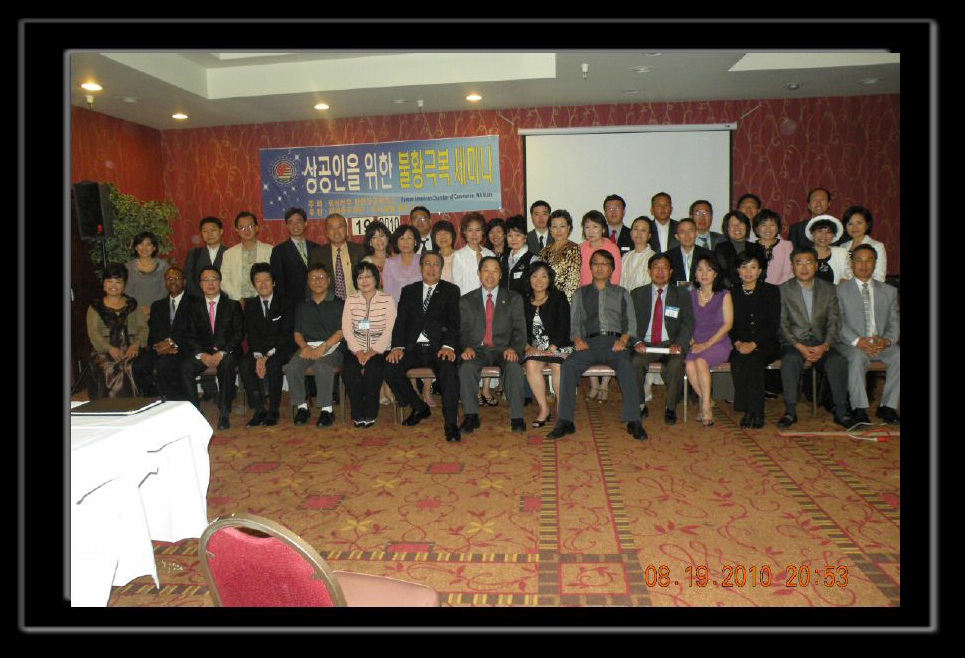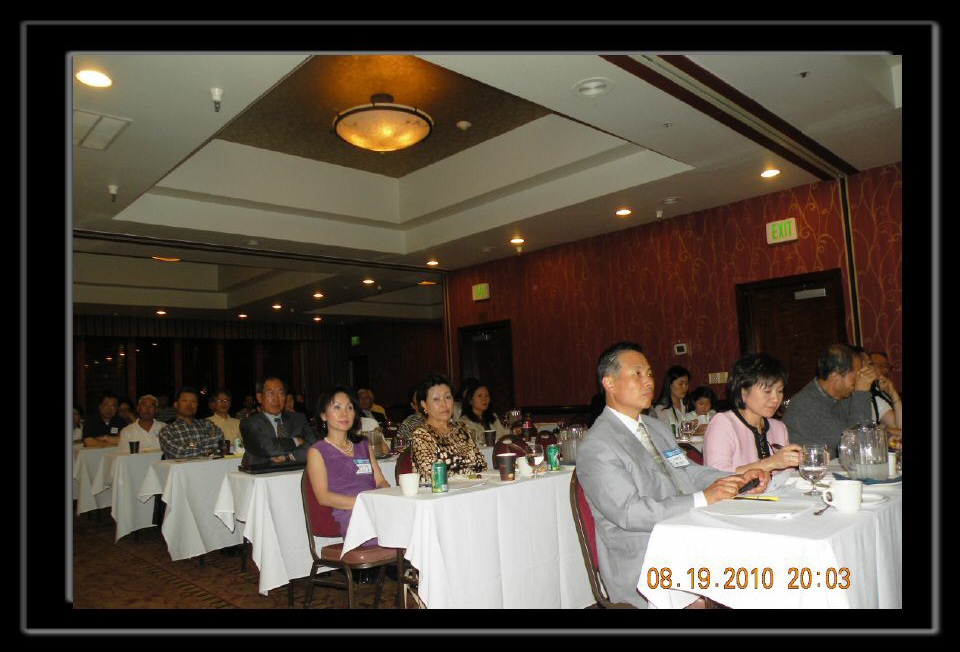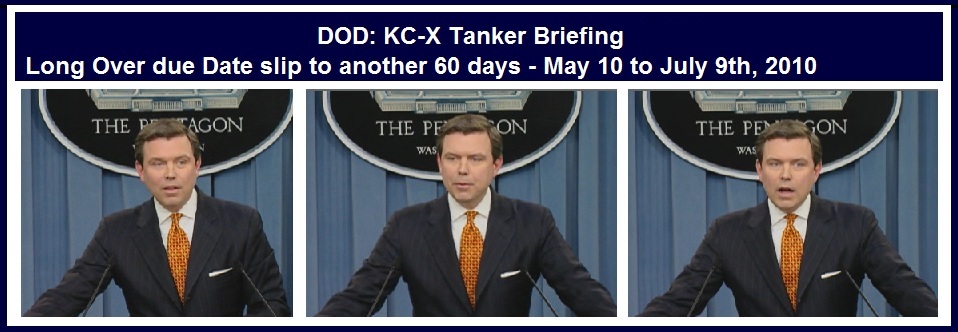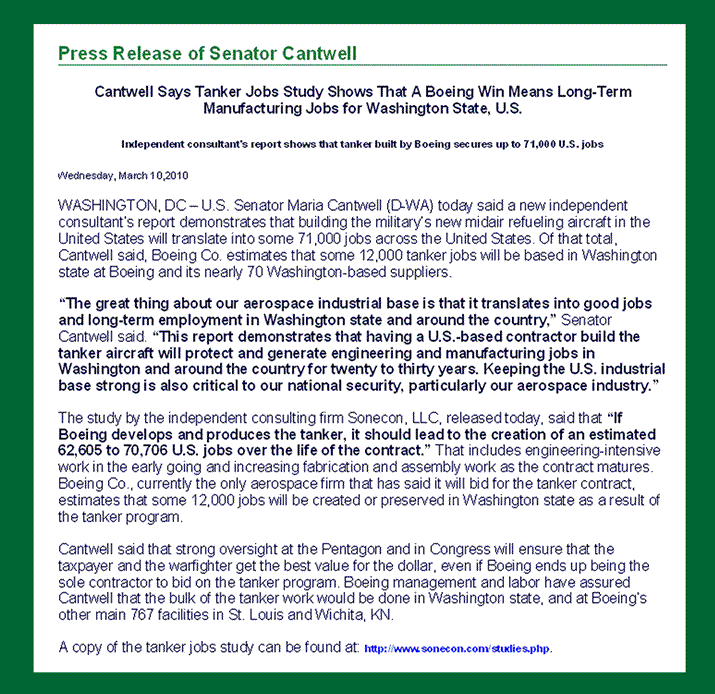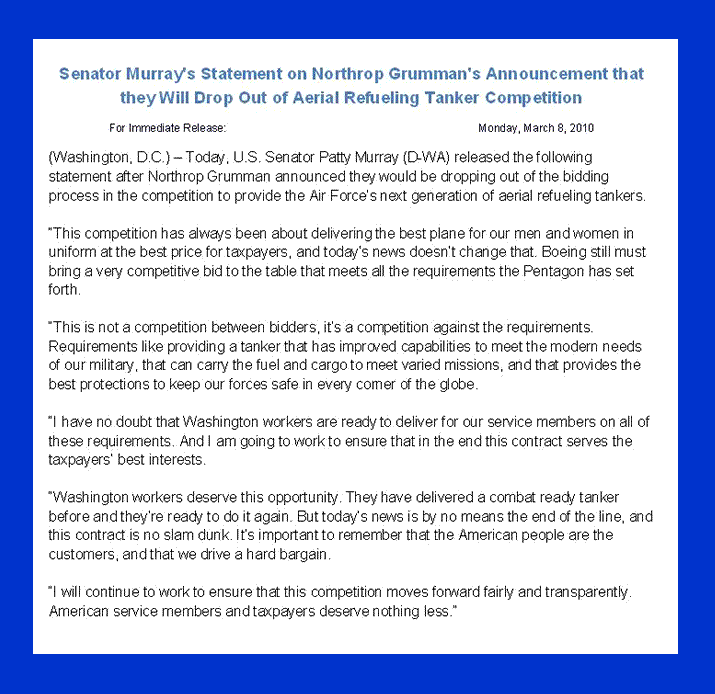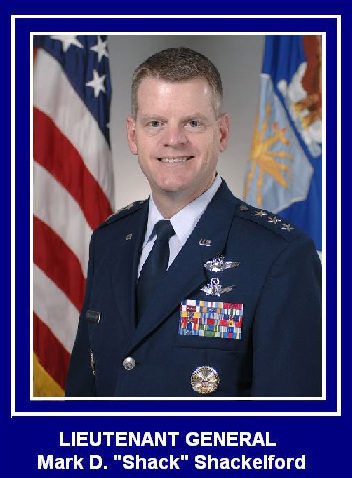DOD News Briefing with Deputy Secretary Lynn and DOD senior leaders
to announce the Air Force KC-46A Tanker contract award
MR. LYNN: At the start of the process, we made several
commitments. We committed that the source selection for the KC-X would be fair,
open and transparent; we committed that the process would be driven by clearly
stated requirements defined by the warfighter; and we committed to a fixed-price
contract structure that would deliver the Air Force a capable aircraft at the
most competitive price. Under the oversight of Dr. Ash Carter, the Under
Secretary of Defense for Acquisition Technology and Logistics, the Air Force has
made good on each of these commitments. As a result, this competition favored
no one except the taxpayer and the warfighter. Let me now get to what you really want to hear, and have
Secretary Donley make today's announcement.
SEC. DONLEY: Thank you, sir. It's a pleasure to be here to
formally announce the results of the source selection process for the Air
Force's number-one acquisition priority and operational need. KC-X represents
the first in a series of procurements to recapitalize our aging aerial refueling
fleet.
Last year, we came here to announce a well-conceived strategy
that emphasized our aim to provide a much-needed aerial refueling platform that
would enable the warfighter to go to war on day one. This meant a clear and
disciplined approach to requirements, recognizing the importance of providing
this capability at a price the taxpayers could afford, and a clear description
of how the evaluation would be conducted. We have now completed the source
selection process as described in the request for proposals.
The source selection evaluation phase spanned seven months,
and resulted in an extensive official record. All offerers were aware from the
very beginning of exactly how the evaluation would be conducted. The source
selection evaluation team was composed of a 230-plus-person joint multi-agency
group of seasoned acquisition, maintenance and operational experts. They
conducted multiple internal reviews throughout the source selection process to
ensure a consistent, thoroughly documented and well-supported evaluation
record. To all of them, we say thank you.
Source selection teams work -- understandably so -- immune
from speculation and opinion in a company's acquisition programs, and especially
ones of this magnitude. They do so because they realize that this isn't about
opinions; it's about the integrity of the source selection process as embodied
in statutes, regulation and case law. That's also why we have worked throughout
this process to carefully develop a comprehensive record of our work.
I would also commend the companies and those they represent
for the quality of the effort they put into these proposals. This was a
spirited competition, with both offerers acquitting themselves well. These are
two world-class companies, with long-standing relationships with the department
that we expect will continue.
As promised, we have had ongoing and transparent dialogue
with the offerers, to ensure we had a clear understanding of their proposals,
and that they would have a clear understanding of our analysis of them.
Throughout, we've also responded to requests for information from members of
Congress, and we appreciate the manner in which our oversight committees have
respected the acquisition process and its legal underpinning.
When it came to requirements, we wanted to make absolutely
certain that the warfighter was still in charge of stating their requirements
and that, if those requirements were met, we could go to war on day one.
General Schwartz and I are confident that when our young
pilots, boom operators and maintainers receive this aircraft, they will have the
tools they need to be successful at what we ask them to do.
We've promised a fair, open and transparent process, and we
continue to deliver on that today by sharing publicly those elements of our
analysis permitted by statute, federal acquisition regulations and prior case
law.
Information that is considered proprietary or source
selection-sensitive will not be discussed unless specifically exempted in
regulation or case law, out of deference to the offerers and the process as it
continues forward. In short, today's statement will be the extent of our public
release of information.
This source selection process determined whether or not the
proposals demonstrated the ability of an offerer to deliver all 372 mandatory
requirements, and whether nonmandatory capabilities would be addressed. It also
took into account fleet mission effectiveness and life cycle costs, as embodied
in fuel efficiency and military construction costs. We then requested and
received final proposal revisions from each offerer.
Here is the information that we are able to release. Both
officer -- offerers were deemed to have met the mandatory requirements and were
considered awardable. Because the difference between the total evaluated prices
in present value terms was greater than 1 percent, yielding substantial savings
to the taxpayer, the nonmandatory capabilities, while evaluated, were not used
in determining the outcome.
The contract awarded today is for the engineering and
manufacturing development, the EMD phase, which is valued at over $3.5 billion.
The overall program is valued at over 30 billion (dollars), with a final amount
depending on the options exercised.
The program will deliver the first 18 aircraft by 2017. The
aircraft will be designated the KC-46A.
Following today's announcement, the Air Force will be
available to debrief offerers at their request. We've also indicated to
Congress our willingness to respond to questions, subject to the limitations
I've outlined earlier. We will have no other public comments following today's
announcement, to allow for that process to play out, as it should, between the
government and the companies involved.
We hope that all parties, recognizing the thorough process
and intense multiple levels of review that have gone into this source selection,
will respect the decision and allow this important procurement to proceed
unimpeded. The warfighter deserves nothing less.
I will say that as far as the timing of today's announcement
is concerned, it was simply event-driven. We took the time necessary to ensure
that the offers made were deemed acceptable, that there was a clear
understanding between the government and the offerers, and that a fair and
objective analysis was completed and provided multiple teams the opportunity to
review our work for accuracy and documentation. We have done exactly what we've
said we were going to do, and we took the time to do it right.
A final frequent question regards basing. As we've
consistently said, basing decisions are made in a separate process that involves
other organizations in the Air Force. That process will take place over the
course of the next couple of years.
To the men and women of our Air Force, today's announcement
represents a long-overdue start to a much-needed program. Your Air Force
leadership, supported by Dr. Carter and others throughout the Department of
Defense, is determined to see this through, and we will stand behind this
work.
Today, based on all evaluated criteria, price and the results
of a well-documented process, we announce that the Air Force has selected the
KC-X proposal provided by the Boeing Company.
Thank you very much.
Q: No questions at all?
MR. LYNN: No, Tony. We'll take a few questions. But as
Secretary Donley indicated, there's a lot of proprietary source-selection
sensitive data, so there's going to be some things we can't answer. But go
ahead.
Q: (Off mic) -- was this a relatively close competition?
Did Boeing basically edge out EADS, or was there a wide discriminator. It did
not go into the 93 -- your version of an overtime phase basically, the 93
mandatory. But how close was this? Or was Boeing far superior in meeting the
370 mandatory requirements?
MR. LYNN: I think what we can tell you is Boeing was a clear
winner.
Q: How will you respond to people who thought the EADS was a
-- was a better bang for your buck in this competition? Is this -- is Boeing a
better deal cost-wise to the taxpayer?
MR. LYNN: We went through a process that evaluated
warfighting requirements, evaluated price, evaluated life-cycle costs. And the
process yielded the result it did with Boeing winning.
And I'd just ask Mike if he wants to expand on that.
SEC. DONLEY: No, we outlined the request for proposal and
the acquisition strategy very clearly a year ago, and we followed that process
to conclusion.
MR. LYNN: (Inaudible.)
Q: Secretary, if I'm correct, I think the EMD contract from
2008, realizing that was under a different RFP [request for proposal], that was
actually a lower price.
So what are you getting for the $3.5 billion? Do you get
airplanes? Do you get test articles? How much flight test do you get? And why
is it a different price than last time?
MR. LYNN: Mike.
SEC. DONLEY: This is a completely different competition. We
indicated that from the beginning. I think if you go back and check the record
from a year ago, the EMD phase includes four aircraft I believe.
MR. LYNN: Mm-hmm. That's right.
SEC. DONLEY: But we have nothing more to say about comparing
prices or costs from one competition to another. We indicated from the very
beginning that this was a new competition.
Q: But did the work scope change then to now -- for either
winner or loser? (No audible response.)
MR. LYNN: (Inaudible.)
Q: Any concerns about the protest that could potentially
derail this?
MR. LYNN: I mean, the unsuccessful offerer has a right to a
protest as part of the process. But as we've said from a year ago when we first
came before you, we think we've established a clear, a transparent and an open
process. We think we've executed on that, and that will not yield grounds for
protest.
Q: Do you believe that over the decade that it's taken to
get to this point in finding a new tanker has taught the Department of Defense a
lesson that will help in the future in major procurement processes so that it
doesn't take a decade and three different selection processes to buy something
so important to our national defense?
MR. LYNN: I do think we've learned important lessons from
this process, and we've tried to reflect them in this competition, the way we've
structured it.
And maybe let Ash expand on that.
MR. CARTER: Learned a number of lessons. We've certainly
had the requirements this time absolutely clear from the warfighter. We said
that 366 days ago when we released the RFP.
And also, the contracts are fixed-price contracts, which is
reflective of our belief that this is a tanker that can be well-specified and
well-defined so that it's appropriate contract structure. So in many ways, this
reflects our efforts to deliver better value to the taxpayer and the capability
of the warfighter in a budget circumstance which we all realize is not going to
give us more and more money every year. So we're trying to manage to a budget,
and this is reflective of the kind of discipline in acquisition that's
required.
Q: Alison Burns with KIRO in Seattle.
Is it your understanding that this tanker will be built in
Everett, Washington? And what are -- what is your message today for those
Boeing workers?
And of course, General Schwartz, we'd love to hear from
you.
MR. LYNN: I think we think both companies did a terrific
job. Boeing was the successful offerer. But as Secretary Donley indicated,
they both were strong offerings.
And let me let General Schwartz chime in.
GEN. SCHWARTZ: I would just say that I'm pleased with how
this has produced an outcome after an exhaustive effort by hundreds of the
department's very best people, that we will get about delivering the capability
that's long overdue and will stop talking about it.
MR. LYNN: (Inaudible.)
Q: Is the airport still going to pursue its KCY and KCZ
strategy to replace their remaining tankers?
MR. LYNN: Yes, there will be follow-on.
Q: When do you plan to sign the contract, if you haven't
signed it already? And will you allow for work to begin before the protest
period runs out, or are you going to wait to find out if there's a protest to
begin work?
MR. CARTER: Let me answer a part of that. Yes, the contract
is signed, or will be very shortly. And the -- we gave authorization for that
this afternoon. And work will be able to begin. Obviously, we're mindful of
the process of debriefing the offerors and having them absorb the information
and so forth, but we'll get started -- (inaudible).
Q: When is that debriefing scheduled?
MR. LYNN: It hasn't been -- they have to request it.
Q: Oh.
MR. LYNN: But it's available as soon as they request
it.
Q: Okay.
Q: Quick question, Mr. Carter. For the second and third
phases, if you can be clear, Boeing is not guaranteed those phases, are
they?
MR. CARTER: That's correct. This is for the first 187
aircraft. There will be in the --
MR. LYNN: One hundred seventy-nine.
MR. CARTER: I'm sorry, 179. I apologize. One hundred
seventy-nine aircraft.
Q: So that's not (winner take all ?) for all three
phases.
MR. CARTER: No.
SEC. DONLEY: No.
Q: Thank you.
Q: EADS was very confident that they had the better plane at
the better price. Do you anticipate that they will protest? And if they do,
what would that mean for the production timelines?
MR. LYNN: As I indicated, the unsuccessful offeror has the
opportunity to pursue a protest if they think they have the grounds. We think
we've put together a process that was fair, open and transparent and that does
not provide grounds for a protest.
Q: Can you say how past performance figured in to the
evaluation criteria for this competition?
MR. CARTER: Past performance was part of the mandatory
requirements, so it was a requirement to become a qualified offeror. Both of
the offerors passed that test and were qualified, along with all the other
criteria that Secretary Donley mentioned, that qualified fully both of these
offerors to participate in the competition.
STAFF: I think we'll take one, maybe two more here.
Q: Do you have any more information on how the oversight
process was handled within OSD, as far as -- (off mic)?
MR. LYNN: Ash?
MR. CARTER: The source selection, as we indicated, was in
the Air Force, and it was an individual in the Air Force who was the source
selection authority, as we indicated when we issued the RFP. There were members
of my staff from OSD and elsewhere in the department, both experts and
overseers, that participated in the technical evaluations and also who ensured
that the process was free and fair in the way that -- and followed the rules of
the RFP issued a year ago.
Q: Have you gotten any indication from EADS whether they
will protest? Do you expect one?
MR. LYNN: Just before coming on, we informed both offerors
of the results. That's all that's been done.
Q: Can you give us more of a sense of how many of those
mandatory requirements EADS was unable to meet? And you said it was more than 1
percent? How many --
MR. LYNN: Both companies met all the mandatory
requirements.
STAFF: All right, I can't count very well, but we'll do one
more. Mr. Secretary, you pick the last one.
MR. LYNN: (Name inaudible.)
Q: Three years ago you selected EADS. And back then, you
said this was the best value for the government. Now you're selecting Boeing.
Our understanding is their design hasn't radically changed. How can you account
for that turnaround?
MR. LYNN: We -- I can't account for how the prior
competition went. I think we structured a competition that was fair, that was
based on a variety of factors, including price, including warfighting
capabilities, including life-cycle costs. And Boeing was the clear winner of
that process.
STAFF: All right, folks. Thank you very much.

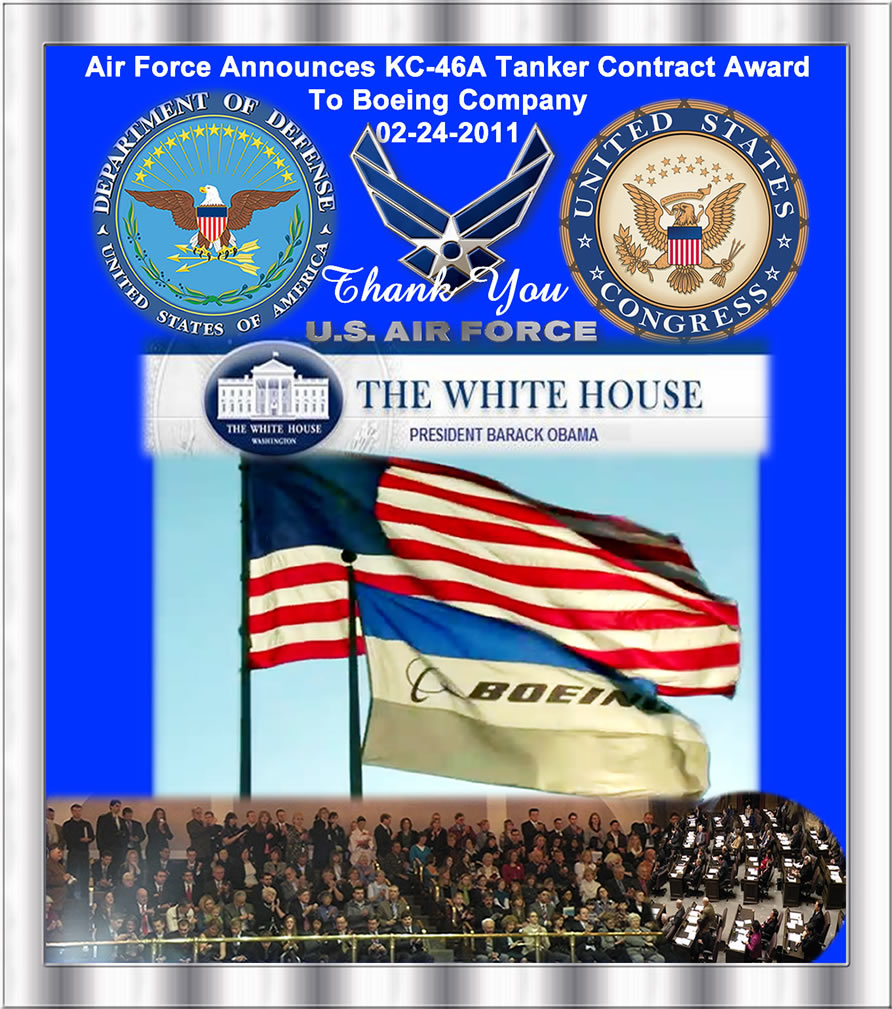
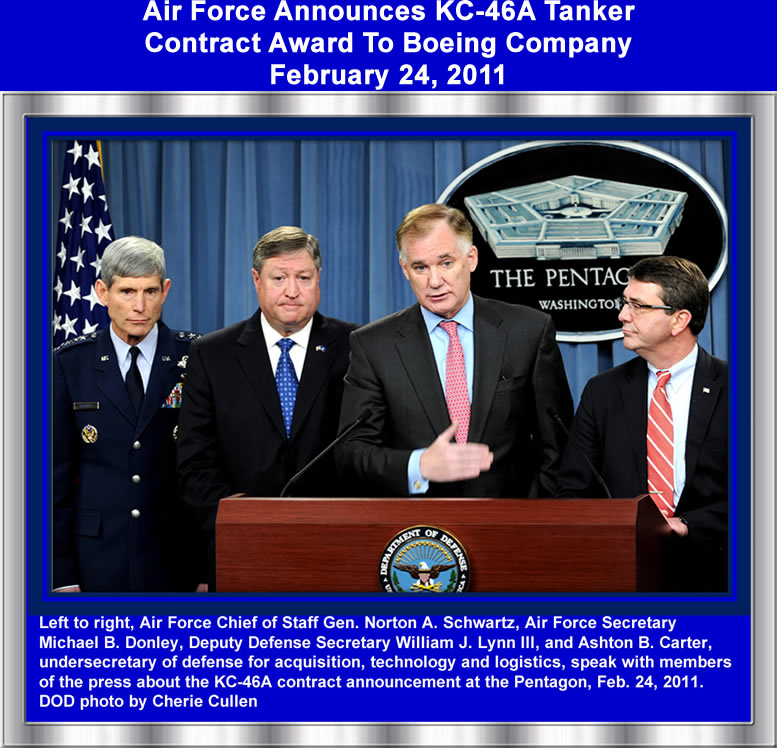
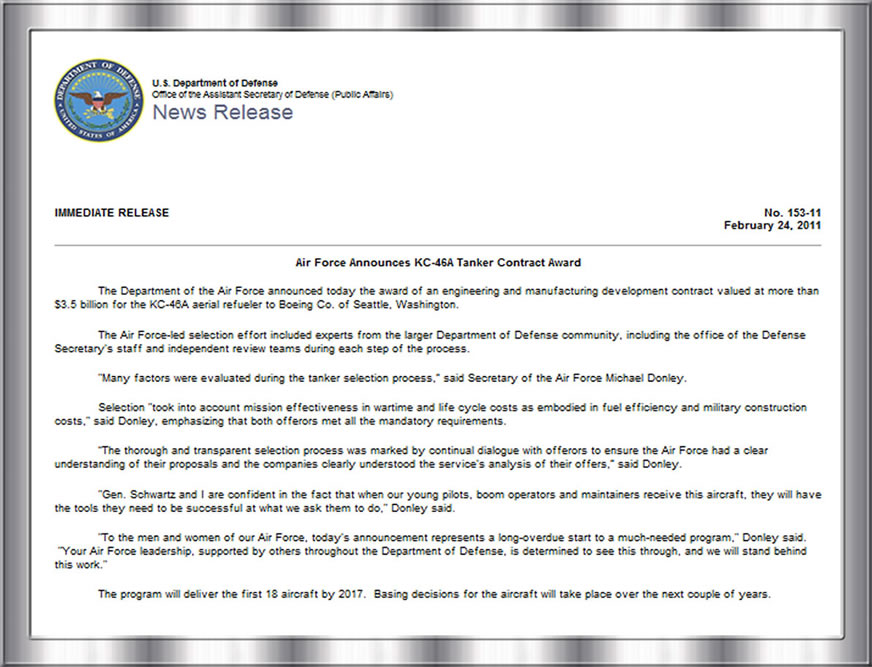

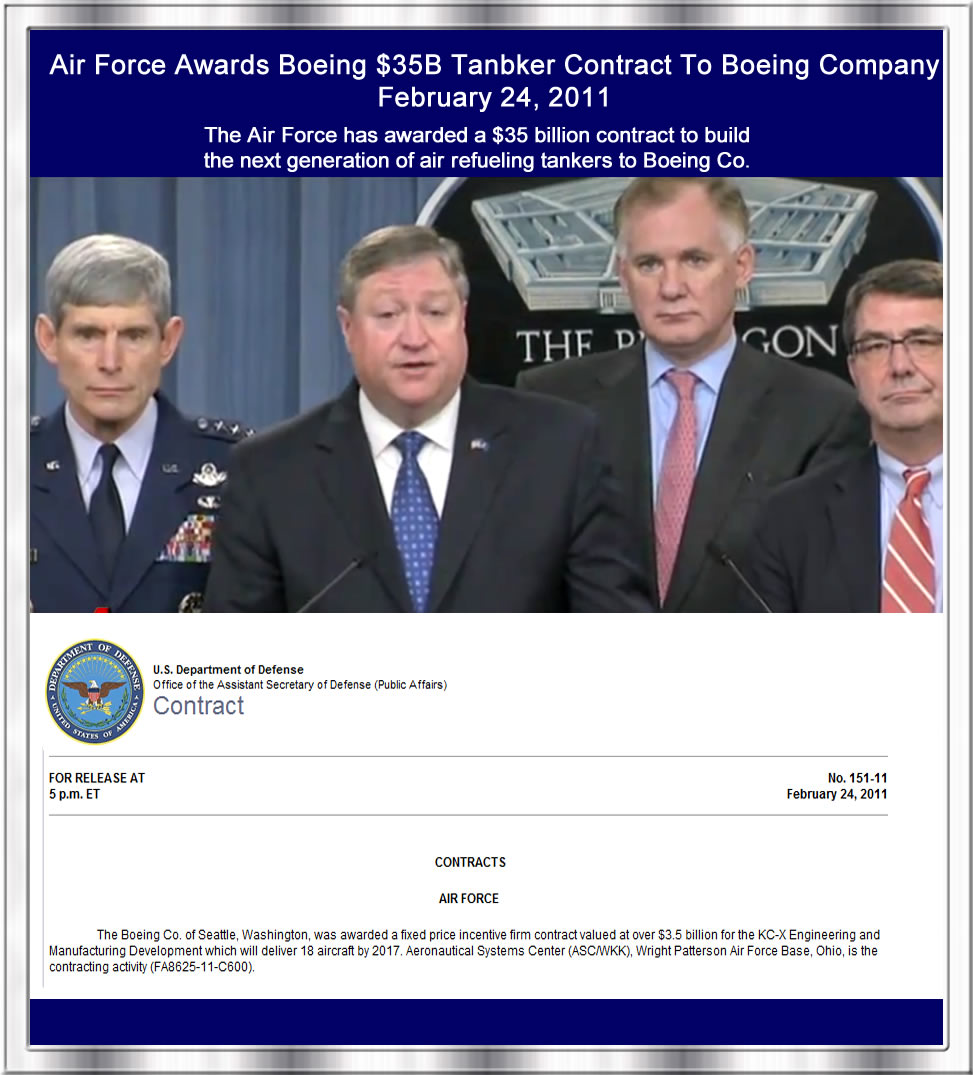
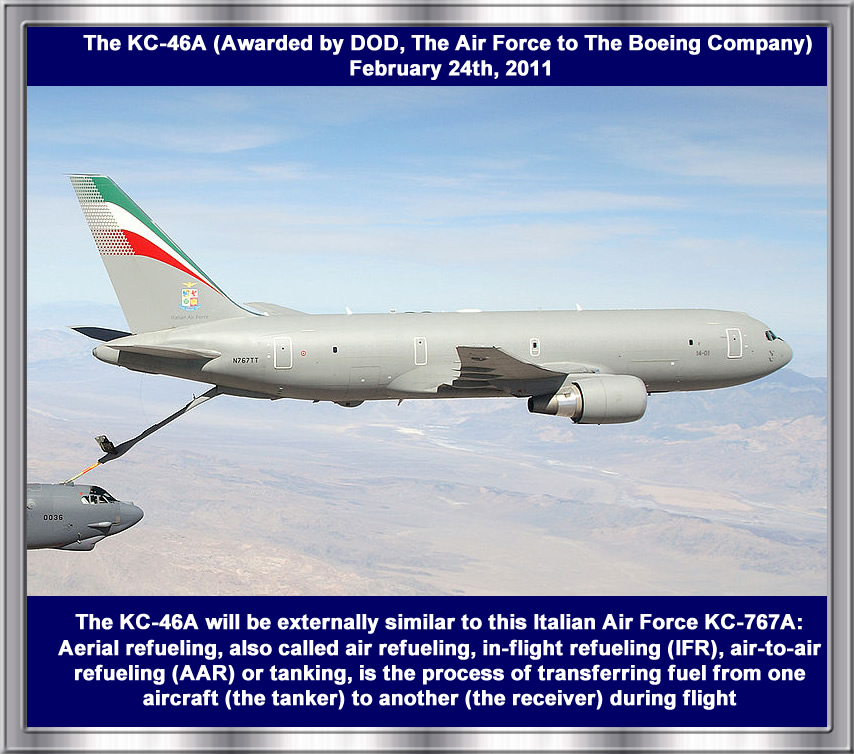
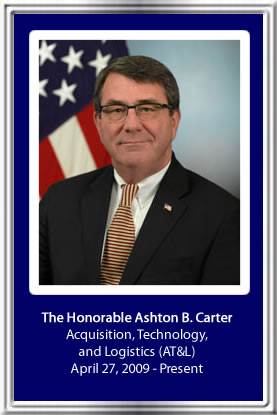

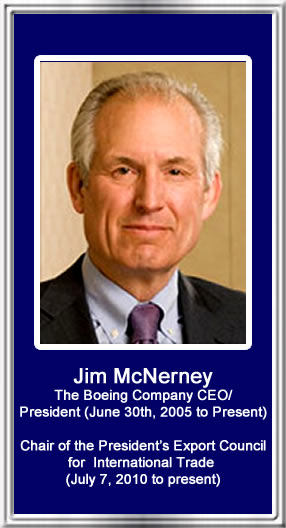
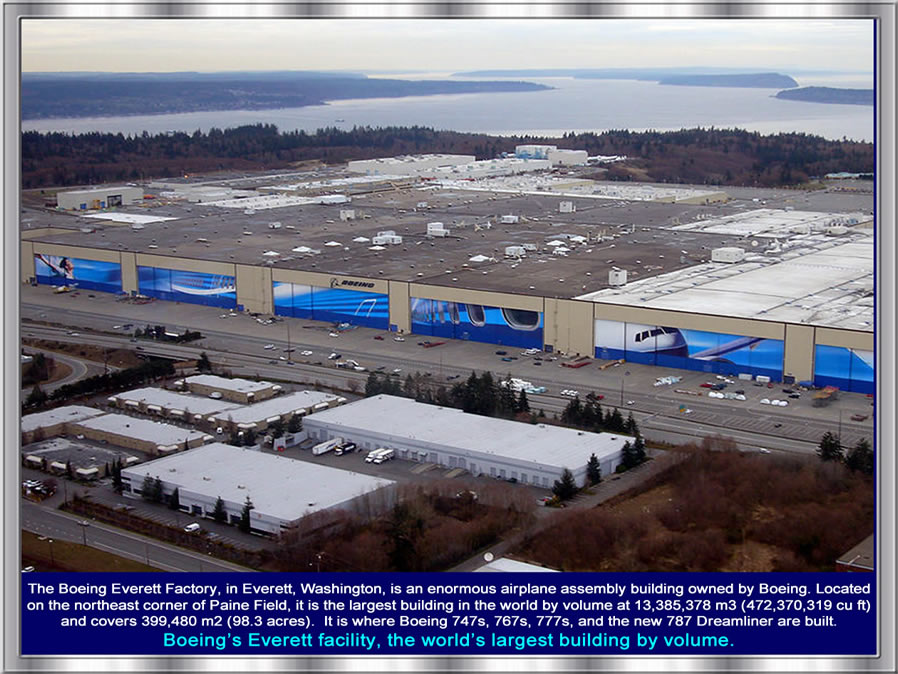
 Video
Video